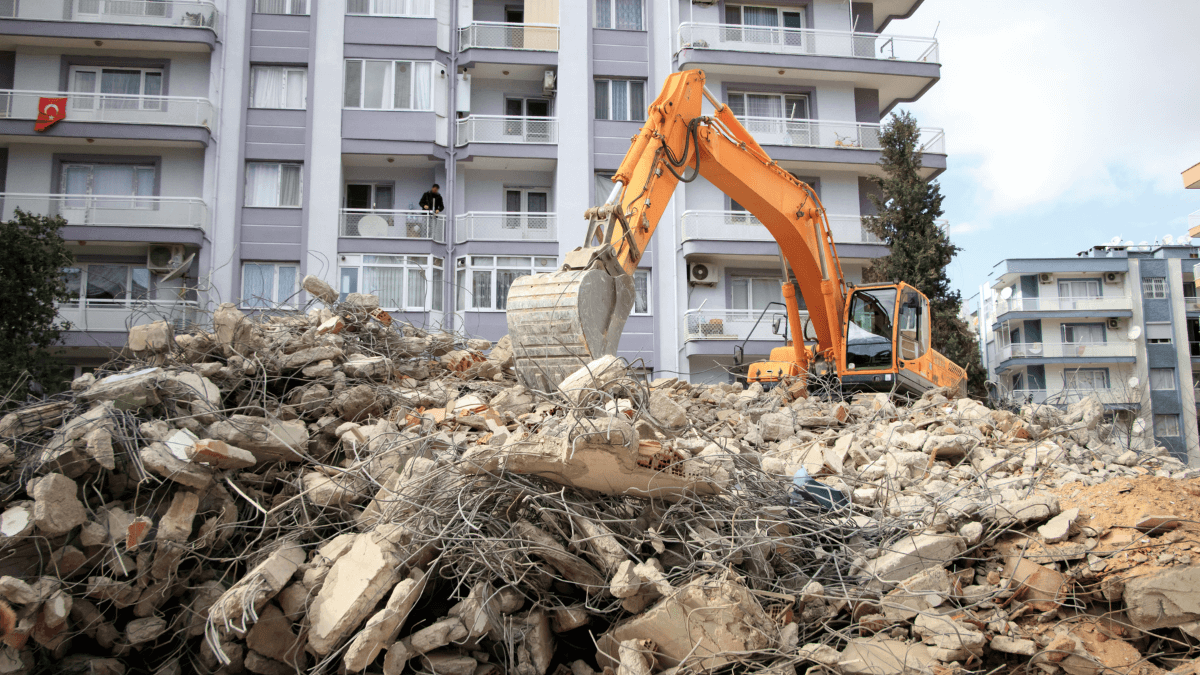Whether you’re just starting out in construction or already have some experience under the belt, you know that construction projects can carry risks that can regularly derail projects and businesses around the world.
Although managing those risks is challenging, it should also be viewed as an opportunity to improve your overall productivity, project management processes, and quality of work.
So, here are eight risks that construction businesses should always be mindful of.
In this article...
Safety Hazards
It makes sense to start with safety hazards, as the construction industry is one of the most dangerous ones in the US and globally.
Therefore, with the protection of human life and health being a top priority, and construction safety hazards being so numerous, it’s not surprising that every construction business should put the best safety practices in place.
In other words, complying with jobsite safety regulations, and providing safety training and personal protective equipment (PPE) should be prioritized to avoid the potentially devastating consequences of jobsite accidents.
Investing in and promoting a safety-first culture also helps you keep productivity up, insurance rates down and safety inspectors at bay.
Additionally, it can aid in avoiding many other risks we’ll cover later, such as delays and cost overruns.
So, to highlight potential points where your jobsite safety practices could be improved and accidents or fines averted, here’s a list of the Occupational Safety and Health Administration’s (OSHA) top 10 cited violations in 2021.

The still unofficial 2022 list hasn’t changed much, and fall protection violations remain at the top.
Interestingly, falls from height are responsible for about a third of all fatal construction injuries, followed by workers being struck by objects or equipment and electrocuted, making them part of OSHA’s “Fatal Four” construction hazards you should watch out for.
Overall, taking every necessary precaution to ensure the safety and health of your construction workers will help you keep this group of construction hazards under control.
Risk of Theft
With all the bigger fish to fry, the risk of theft could be the furthest on your mind, but it’s a risk that, if left unmanaged, can have serious impacts on both the financial and operational sides of your business.
It’s simple. You have valuable construction equipment, tools, and materials that circulate on jobsites during the day, stay there overnight and pass through many hands.
So, the risk that they will be stolen (or just lost or misplaced) is high, yet construction businesses often underestimate its adverse effects on their overall profitability and productivity.
To manage this risk, you might need to apply a whole range of security measures to prevent theft on your construction sites, so here are just six to consider:
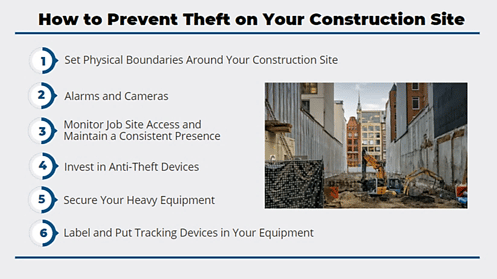
As you can see, technology plays a major role in preventing jobsite theft.
One of those measures that may be highly effective in preventing theft and loss—while also being practical and affordable—refers to different asset tracking solutions that allow you to track the location, usage, and maintenance of your equipment and tools at all times, like GoCodes Asset Tracking.

Of course, the actions you’ll take to manage the risk of theft will depend on your company’s size and budget, construction equipment and tool inventory, specific jobsite requirements, etc., but remember that high-tech doesn’t necessarily mean high cost.
Labor Shortages
The long-standing risk of labor shortage in the construction industry is extremely important—without the necessary number of workers, construction projects can’t be completed on time, within budget, or at all.
In fact, 62% of contractors say it’s very hard to find skilled workers, while 56% express concern over the adequate skill levels of their workers.
There are various methods you can employ to overcome labor shortages:
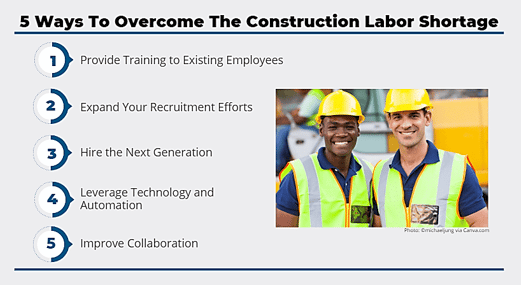
If you’re unsure of your workers’ skills, the first thing you should do is provide adequate training to eliminate skill and knowledge gaps in your crew, improving overall team productivity and increasing employee retention.
Expanding your recruitment efforts can mean posting online job ads, attending job fairs, connecting with your local community, giving presentations at high schools and community colleges to attract younger generations, and so on.
You can also streamline your operations and appeal to the next generation by leveraging technology and automation, such as drones, robots, remote-controlled equipment, and hundreds of construction software and mobile applications, which are quickly changing the way construction is done.
Of course, amidst a labor shortage, your business should first focus on retaining existing employees by offering competitive salaries and benefits, good work-life balance, career opportunities, etc., as the best way to manage this risk proactively.
Subcontractor Default
Another risk that should be managed is subcontractor default, or those situations where subcontractors underperform for any reason, which can then throw off the entire project schedule and budget.
To minimize this risk, construction businesses should, for starters, prequalify their subcontractors.
When it comes to prequalifying subcontractors, you should consider these eight criteria given by construction project managers interviewed by Priority Matrix:
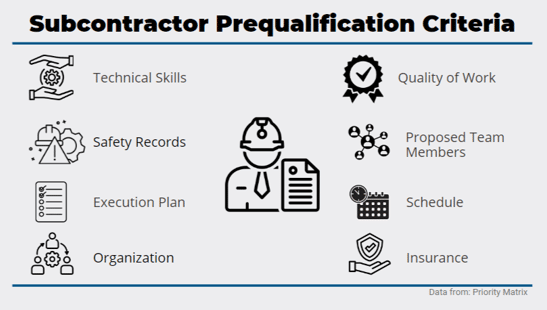
As you can see, the priority is checking their technical skills, quality of work, and safety records, which combined are the best benchmarks for selecting high-performing subcontractors.
Of course, there’s much more to hiring great subcontractors, such as verifying professional licenses and credentials, required bonds and insurance, and references.
The second key element is creating a subcontractor agreement that clearly states the subcontractor’s scope of work and deadline for completion, along with contractual safeguards against their underperformance.
Finally, nothing can keep this risk under control better than open communication and coordination with your subcontractors while being aware that clear expectations and positive feedback will build strong business relationships.
Change Orders
Naturally, changes in construction projects, big and small, are unavoidable, but your business
should be mindful of the risks that change orders, when improperly managed, pose to the productivity and profitability of the project.
In other words, when something needs to be changed in the project due to the client’s wishes, unexpected site conditions, or incorrect estimates, it’s crucial that any such change is documented in a change order and signed off on by the client.
This will prevent your employees and subcontractors from doing work that’s no longer required and then doing rework, ensure that you’re paid for all out-of-scope work, and manage the client’s expectations.
Of course, change order management can get pretty complex, but you can use affordable construction management apps that digitize and automate the entire process, like Extracker:

This mobile app allows the general contractor, subcontractors, and the client to record their change requests in the app, where they are immediately visible to the persons authorized for their review and approval (the client, architect, engineer, etc.).
This results in total transparency between all stakeholders, reduces the risk of mistakes, and saves time.
It also creates a digital trail of evidence that prevents misunderstandings and disputes.
Overall, poorly managed change orders can be a serious risk to the project schedule and budget, so make sure that all project changes are documented and approved.
Project Delays
The last three risks, starting with notorious project delays, are often the result of all the construction risks we’ve mentioned thus far, as well as an array of other risks that any construction project can face.
It’s safe to say that delays keep reducing profits, tarnishing the reputation and testing the nerves of many contractors.
Expectedly, the ways to prevent this common construction risk are as vast and varied as the reasons why delays occur, be it changes in project scope, poor planning, bad weather, or countless other unpredictable things that can happen during the project.
So, although managing the risk of delays requires careful assessment, planning, and execution, there are steps that can prevent many construction delays:
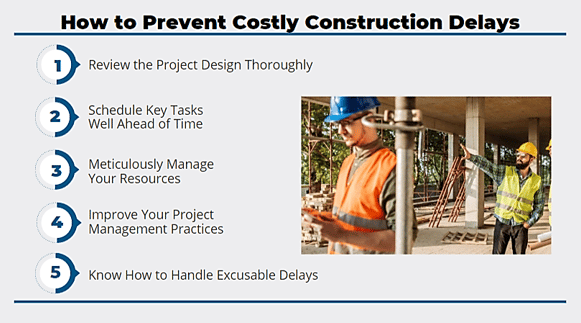
You can read more about each step in our article linked above, and we’ll pick just one example.
For instance, any improvements made in managing your construction resources—labor, equipment, and materials—will automatically reduce the risk of various delays that could otherwise occur.
If resources are not meticulously managed, an essential worker could get sick with no replacement planned, the equipment could break down due to poor maintenance, or materials could be unavailable due to unexpected shortages.
Overall, remember that delays can be kept under control by holistic and adaptive planning, scheduling, and budgeting, and open communication between all stakeholders throughout the project lifecycle.
Cost Overruns
Closely following delays, cost overruns are another common construction risk that has proven to be the downfall for many construction ventures, resulting in unpaid bills, disputes, and bankruptcies.
A range of risks can cause cost overruns, but inaccurate project estimates and poor cost tracking are often the culprits behind a company’s reduced profits.
Other causes include errors in project design, inefficient site management, administration mistakes, and unqualified staff, as discussed in the Autodesk article shown below.
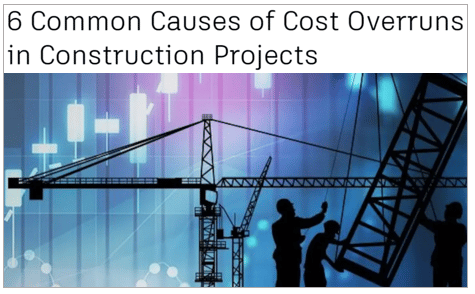
So, when you become aware of the causes and effects that unplanned costs can have on the project budget and schedule, what can you do to avoid them?
You can employ technology, namely one of many construction management software solutions that will allow you to improve cost estimates, track costs, and optimize almost any aspect of your business, thus eliminating or minimizing many sources of overruns.
If you are already doing so, it’s time to identify the root cause and take other measures described in our article on handling construction overruns.
Overall, the risk of cost overruns should be closely watched and carefully managed to protect your business from their often-devastating effects.
Payment Disputes
Payment disputes are another common construction risk that your business should be aware of, as they can stifle even the best-run construction companies.
The problem of late payments in construction has a long history, but its ultimate result is that 91% of construction businesses are not always paid on time, and 89% are not paid in full on every job, according to the 2021 Construction Payment Report.
So, what can contractors do to avoid payment disputes?
Here are a few ideas that the contractors interviewed for that report offered when asked what speeds up their payments, meaning there was no dispute to get in the way of being paid on time.
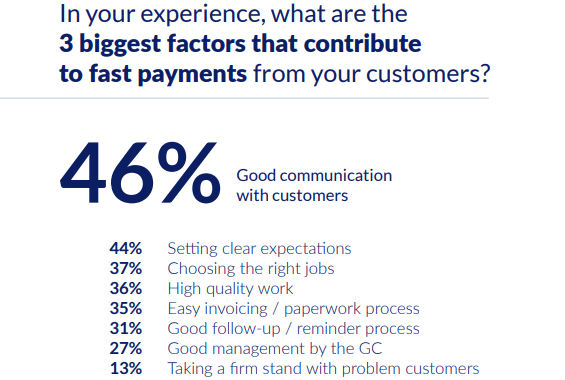
As you can see, good communication tops the list, which means that it’s extremely important to be open and honest with your clients from the start.
When this is combined with clear expectations, choosing the right job and high-quality work, most risks of payment disputes are minimized.
Still, construction businesses can also use various other tools like preliminary notices, invoice reminders, demand letters, and mechanic’s liens, all of which can be leveraged to manage the risk of payment disputes efficiently.
Conclusion
Having gone through eight risks any construction business should be mindful of, from safety hazards to payment disputes, it’s clear there’s a lot to consider.
Although effective risk management is challenging, we hope this article has provided you with ideas on how those risks can be prevented or minimized.
Properly managed, they can even be used as opportunities to streamline your operations, improve overall productivity and profitability, and enhance quality, client satisfaction, and reputation.




